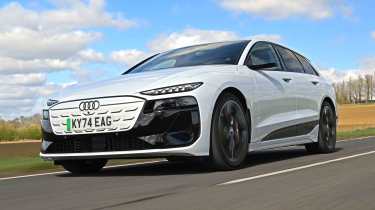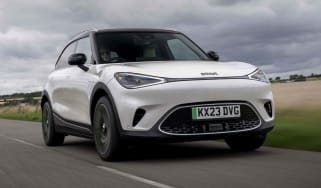Audi A6 Avant e-tron review
There are flaws in terms of packaging, but the Audi A6 Avant e-tron’s dynamic performance and range are excellent

Our opinion on the Audi A6 Avant e-tron
While Audi first joined the EV fray with SUVs, the A6 Avant e-tron is arguably a better prospect than any of the pure-electric models that came before it. The combination of an estate car body and a powerful electric powertrain taps into a particular niche that Audi carved for itself with its petrol and diesel-engined cars; and with a long range and fast-charging capability, the A6 Avant e-tron delivers the kind of tech the company is also famous for. There’s not quite as much space inside as you might expect from such a large family car, though, which might be a deal breaker for some buyers tempted to make the switch to an EV.
| Key specs | |
| Fuel type | Electric |
| Body style | Five-door estate |
| Powertrain |
83kWh battery, 1x electric motor, rear-wheel drive 100kWh battery, 2x electric motors, four-wheel drive |
| Safety | Five-star Euro NCAP (2025) |
| Warranty | Three years/60,000 miles |
About the Audi A6 Avant e-tron
Before we start, let’s clear something up on behalf of Audi, which is in the habit of confusing people with its recent model-naming policies. While the brand had previously said that it would reserve even model numbers for its electric cars and odd ones for internal-combustion models (the reason why the A4’s replacement is called Audi A5), the A6 e-tron has been joined by another new A6, which is available with an ICE engine and varying levels of hybrid assistance.
The pair aren’t related mechanically; the standard A6 uses the same PPC platform – itself an updated version of the VW Group’s MLB architecture – as the aforementioned A5, while the A6 e-tron and sportier S6 e-tron ride on the PPE platform that underpins the Audi Q6 e-tron SUV and Porsche Macan Electric.
Used - available now
Prices for the A6 Avant e-tron are slightly higher than they are for the Sportback version, starting from just over £65,000. This is for a model in Sport trim, while upgrading to S line spec costs another £3,500 on top of that. Both are available with three powertrain configurations that add £8,000, and then another £5,000 again to the standard car’s price.
The standard A6 Avant e-tron has an 83kWh battery and a 281bhp electric motor that drives the rear wheels. Above that sits the e-tron Performance, which boosts power to 362bhp but also gets a heavier 100kWh battery. Then there’s the quattro, which is four-wheel drive courtesy of two electric motors (one on each axle) and packs 422bhp.
The top-spec S6 Avant e-tron, meanwhile, sits at the £100,000 mark, although that’s a similar level to the highest-spec BMW i5 Touring. It has quattro four-wheel drive as standard, the same 100kWh battery as the A6 Avant e-tron and a two-motor set-up that offers 496bhp.
Performance & driving experience
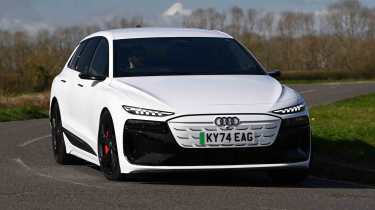
| Pros |
|
| Cons |
|
The three powertrain options in the A6 Avant e-tron deliver performance that ranges from decent to strong, while the S6 version takes things to another level.
Kicking off the line-up is the 281bhp standard model. which also has 435Nm of torque. However, every version of the A6 Avant e-tron is fitted with launch control, which gives a brief power boost on the standard car to 322bhp, although torque remains unchanged.
For the Performance model, there’s 362bhp and 565Nm of torque, while the launch control boosts power to 375bhp. For the quattro model, there’s 422bhp and a torque split of 275Nm front and 580Nm rear, while the launch control boosts the power output to 456bhp.
For the S6 Avant e-tron, the electric motors combine to offer up 496bhp, which increases to 543bhp when launch control is selected. Then there’s the torque, which stands at a thumping 855Nm.
Electric motors, 0-60mph acceleration and top speed
Acceleration figures for the A6 Avant e-tron are decent, with the base model managing 0-62mph in seven seconds exactly, or six seconds when launch control is activated. The Performance model has a quoted 0-62mph time of 5.4 seconds (but no quoted time with launch control), while the quattro version has a time of 4.7 seconds, or 4.5 seconds in launch control mode.
We’ve tried the S6 Avant e-tron, and as you’d expect from a fast Audi estate, there has been no holding back. While it shares its PPE tech with the SQ6 SUV, there’s even more punch on offer here. The full 543bhp that is deployed to all four wheels delivers a 0-62mph time of 3.9 seconds – not bad when there’s just over 2.4 tonnes to shift.
On the road, that shove doesn’t feel dramatic; without the flare of noise and gearshifts we’re used to in fast Audi estates, the feeling here is a silent, relentless surge. It appears effortless – in everyday driving it seems like there’s always so much power in reserve. Long pedal travel and a linear throttle response mean it’s easy to modulate that power, so it doesn’t feel intimidating to drive.
Top speed for every regular version of the A6 Avant e-tron is limited to 130mph, but the S6 model is given a higher threshold, at 149mph.
Town driving, visibility and parking
Our experience of the S6 e-tron should be a good marker for the rest of the line-up. The flagship model rides on air suspension, and despite sitting on huge 21-inch wheels, its ride comfort is excellent.
It manages to float over rough surfaces, doesn’t throw its occupants around over larger bumps, and knocks and bangs from drain covers and potholes are well isolated from inside the cabin. While the S6 is undeniably large, the smoothness of the controls makes it a relaxing car to drive at low speeds, too – at least when the adaptive motor regeneration is turned off; as with all systems of its type, it’s unpredictable, and the inconsistent response is a little unnerving.
B-road driving and handling
The S6’s excellent comfort may lead you to believe that it’s going to be out of its depth on a twisty road, but instead it manages to use that compliance to its advantage. Thanks to an uncanny ability to control its mass, the chassis can tackle some difficult B-roads without the suspension bucking at the end of its travel, as is the case in many other hefty EVs.
Although the steering isn’t loaded with feedback, the weighting and response feel ideally matched to the chassis, which – combined with strong grip – enables it to flow along a road at an impressive pace. This factor alone makes the S6 more pleasing to drive than the BMW i5 Touring.
Motorway driving and long-distance comfort
The S6’s slippery body shape pays dividends at higher speeds, where it barely creates a whisper of wind noise around the passenger compartment. Much like at lower speeds. However, more tyre rumble makes it through to the cabin than in the i5. The Audi’s high-speed ride and stability are excellent, though.
“The S6 e-tron is fitted with adaptive air suspension, which doesn’t dramatically adjust how the car behaves on the road, but can raise the ride height by 30mm to improve ground clearance over bumpy terrain, or lower the standard ride height by 10mm to reduce aerodynamic drag at speed and improve efficiency.” – Alex Ingram, Chief reviewer, who tested the S6 Avant e-tron against the BMW i5 M60 Touring.
| Model | Power | 0-62mph | Top speed |
| A6 Avant e-tron | 322bhp | 6.0s | 130mph |
| A6 Avant e-tron performance | 375bhp | 5.4s | 130mph |
| A6 Avant e-tron quattro | 456bhp | 4.5s | 130mph |
| S6 Avant e-tron | 543bhp | 3.9s | 149mph |
Range, charging & running costs
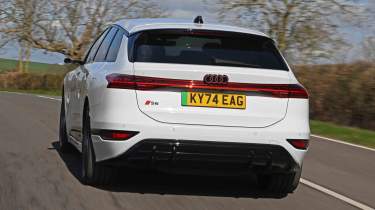
| Pros |
|
| Cons |
|
The A6 Avant e-tron features the same batteries and efficient electric powertrain as the Sportback version, and range figures are around 20 miles short of what that sleeker model can achieve. Official figures for the standard car with its 83kWh battery claim a range of up to 364 miles, while the 100kWh Performance model can travel up to 437 miles on a single charge. The quattro model has a slightly shorter range at 418 miles, but that’s still impressive for an EV. A strong range of 391 miles for the S6 Avant e-tron is likely to be as much as you’ll get from a petrol estate with similar firepower.
Electric range, battery life and charge time
We tested the S6 Avant e-tron in mild conditions – around 12 degrees Celsius – and during our time behind the wheel, we achieved around 3.1 miles per kWh. Given that the S6 is the high-performance version of the A6 Avant e-tron line-up, and a large proportion of motorway mileage contributed to that figure, that’s a reasonable return, and it means that the real-world range would be just shy of 300 miles. While that’s down on the official claim of 391 miles, we’d expect things to improve further in warmer weather – but bear in mind that this will also drop in the winter months.
When you do need to stop to top up the battery, you won’t need to wait too long before you get going again. Audi says that the A6 e-tron will charge at up to 270kW, ranking it among the fastest-charging cars on the market today. That means a 10-80 per cent charge of the 100kWh battery – the equivalent of adding 206 miles based on our real-world efficiency figures – can take as little as 18 minutes.
Those looking to charge their A6 Avant e-tron at home using a typical 7.4kWh wallbox charger will find it’ll take a little over 12 hours to fully recharge the 83kWh version. The 100kWh version will take a little longer due to its greater capacity, at just over 15 hours.
| Model | Battery size | Range | Insurance group |
| A6 Avant e-tron | 83kWh | 364 miles | 43 |
| A6 Avant e-tron performance | 100kWh | 437 miles | 44 |
| A6 Avant e-tron quattro | 100kWh | 418 miles | 48 |
| S6 Avant e-tron | 100kWh | 391 miles | 50 |
Insurance groups
Depending on model, insurance groups range from 43 for the entry-level A6 e-tron up to group 50 for the S6.
Tax
Since April 2025, the vehicle excise duty (VED) rates among new cars are largely the same whether there’s a petrol, diesel or electric power source driving the wheels – at least from years two to six, where the only variance comes from whether or not the car in question cost over £40,000 when it was new.
In the first year, the A6 e-tron’s VED rate is just £10, but that’s absorbed into the on-the-road price anyway. So although petrol cars cost more to tax upfront, it won’t be a massive consideration to those who are spending six figures or more on a new car.
Depreciation
Depending on the version you choose, the A6 Avant range is predicted to cling on to between 49 and 55 per cent of its original value after three years or 36,000 miles. Those initial estimates suggest that it’ll depreciate less than the Mercedes EQE, which retains 36-42 per cent, although this model isn’t offered as an estate.
To get an accurate valuation on a specific model check out our free car valuation tool...
Interior, design & technology
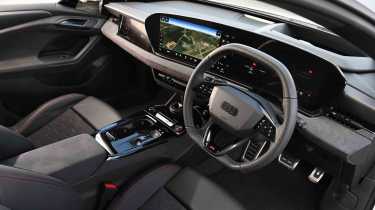
| Pros |
|
| Cons |
|
The cabin is loaded with outstanding tech and it feels suitably luxurious – but it can’t quite match the high-quality finish or sense of occasion of the BMW i5.
Interior and dashboard design
Audi’s latest-generation cars seem to be lacking a bit of creativity when it comes to their appearance, and the huge screens are the culprit. With two large displays crowding out the rest of the dashboard, there really isn’t much scope for the designers to make the A6 look any different from the latest A5, or the Q6 e-tron SUV.
The overall appearance is fairly clean and tidy, and although the large touch panel mounted on the door, which controls the lights, locks and mirrors (or rear-view cameras, when fitted), looks glitzy, it isn’t as tactile as real buttons would be.
Materials and build quality
It didn’t feel like too long ago that Audi blew its competition clean out of the water when it came to fit and finish. While the A6’s cabin certainly feels special at first glance, it doesn’t quite seem so flawless under closer scrutiny. Some trim panels don’t line up with the precision that we’ve seen from Audi in the past, and some areas in particular – such as the surround for the digital rear mirror screens – look a little like an afterthought.
It is by no means poor in isolation, but the BMW i5 feels like a more expensive product – but then, it is. Just not substantially enough for the Audi to not seem inferior.
Infotainment, sat-nav and stereo
Audi hasn’t held back with its tech. The top-spec S6 features the latest in the brand’s OLED lighting technology at the rear; both tail-lamps feature five segments, each housing 45 triangular OLED panels. These can be customised to display several preset patterns, including one which appears to gently twinkle. Audi says that they’re lighter and more efficient than LED lights, and that the intricacy of those elements allows the tail-lights to display animations, including moving graphics to warn other drivers of hazards ahead.
Slightly less ground breaking but no less glitzy is the panoramic glass roof. It’s made of nine panels with switchable transparency, which Audi calls a ‘digital curtain’. Whatever you want to call it, it does look quite cool as the panels switch from transparent to translucent at the touch of a button – although they still let some light through at all times.
Ahead of the driver, an augmented-reality head-up display projects driving data right into their field of view. The set-up can present nav instructions with moving arrows before a turn, and display warnings if it thinks you’re an unsafe distance from the vehicle in front.
One piece of tech we’d steer clear of is the ‘virtual’ side mirrors. The small cameras are among the better examples of this tech that we’ve tried, but they still make parking manoeuvres unnecessarily trickier than with traditional mirrors.
“Be it petrol, diesel or electric, there’s not much else on the market that can claim to be as slippery as the A6 e-tron family. In Sportback form, its drag coefficient of 0.21Cd makes it the most aerodynamically efficient car Audi has ever produced. Although the Avant doesn’t quite cut through the air as cleanly, its figure of 0.24Cd is still class leading, according to Audi.” – Alex Ingram, chief reviewer. Tested the S6 Avant e-tron against the BMW i5 M60 Touring.
Boot space & practicality
| Pros |
|
| Cons |
|
For such a large car, the Audi doesn’t offer as much cabin or boot space as we’d like or expect.
Dimensions and size
Compared with the combustion-engined A6 Avant (both the outgoing model and the new one introduced in 2025), this e-tron version is slightly shorter but with a longer wheelbase, plus it’s a little taller and wider. Overall, the A6 Avant e-tron is shorter and lower than the BMW i5, but it’s wider in an effort to increase interior space.
| Dimensions | |
| Length | 4,928mm |
| Width | 1,923mm |
| Height | 1,493mm |
| Number of seats | Five |
| Boot space | 502-1,422 litres (plus 27 litres under the bonnet) |
Driving position, seats & space in the front
As we’ve come to expect from Audi, the driver’s seat has a huge range of adjustment. And with a steering wheel that also offers near-endless permutations, it means that drivers of all shapes and sizes can get comfortable.
Seats & space in the back
Rear kneeroom isn’t quite as generous as we’d hope, and the A6 Avant doesn’t offer significantly more space than some family hatchbacks – never mind big estate cars. The floor is a little high relative to the seat base, which means that under-thigh support isn’t outstanding. But at least there’s plenty of foot room under the front seats.
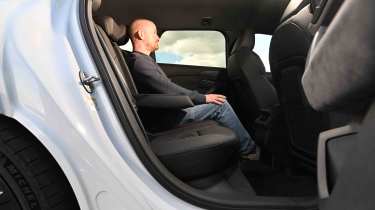
Boot space
Much like the rear passenger area, the luggage space doesn’t quite hit the mark. At 502 litres, the A6 Avant’s boot is by no means small, but it’s not exactly outstanding for a near five-metre-long estate car, either. The BMW i5 Touring offers much more at 570 litres, but the A6 does have a modest frunk, which is a great place to store charging cables. Drop the Audi’s rear seats, and the volume grows to 1,422 litres – still behind the competition.
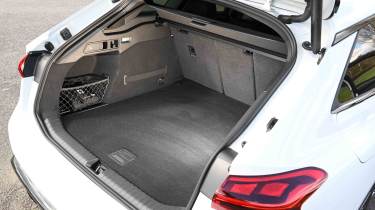
“Large estate cars are popular for towing, and the introduction of an electric powertrain to the A6 Avant doesn’t hamper its ability to haul heavy loads. There’s a maximum braked towing weight of 2,100kg for every model in the line-up, including the S6 Avant e-tron.” – Alex Ingram, chief reviewer. Tested the S6 Avant e-tron against the BMW i5 M60 Touring.
Reliability & safety
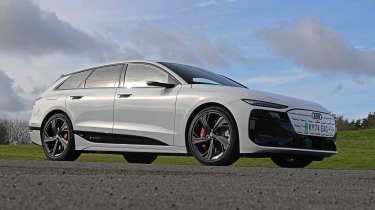
| Pros |
|
| Cons |
|
The A6 aced its Euro NCAP assessment in 2025, chalking up a maximum five-star rating. Its score of 92 per cent in the Adult Occupant Protection is the best mark of any car tested this year to date.
But Audi’s performance isn’t quite so impressive when it comes to customer satisfaction. In our 2024 Driver Power survey, owners rated the maker in 27th place out of 32 brands. Owners cited their cars’ steering and braking as the areas where they were left feeling most disappointed.
| Key standard safety features |
|
| Euro NCAP safety ratings |
|
Buying and owning
Our best buy: Audi A6 Avant e-tron Sport Performance
While quattro four-wheel drive is Audi’s signature, the extra range the Performance model offers is enough to justify sticking with that version.
Audi provides a three-year, 60,000-mile warranty on all of its models, including its electric range, plus three years of roadside assistance and breakdown cover. A separate warranty covers the battery for eight years or 100,000 miles.
The A6 Avant e-tron’s service intervals are set at every two years with an unlimited mileage limit, which will be good for high-mileage drivers. Audi offers its owners a choice of service plans, but they’re pricey considering the minimal work needed to maintain an electric vehicle – each biennial trip to the dealer will cost close to £500.
Audi A6 Avant e-tron alternatives
The main rival for the A6 Avant e-tron is the BMW i5 Touring, which is better for interior space and upmarket quality. Its official range figures aren’t quite as long as the Audi’s, though. The Mercedes EQE isn’t available as an estate (so your only alternative there is the Mercedes EQE SUV variant), and neither is the Tesla Model S, which is also only offered in left-hand drive. A far better option is the Porsche Taycan Sport Turismo, which is great to drive. The only other thing we’d suggest is asking yourself if the Avant offers anything more than you need over the A6 Sportback e-tron – the hatch version offers slightly more range for a couple of thousand pounds less than the estate.
Audi A6 Avant e-tron pictures
Frequently Asked Questions
It has its strengths in terms of range and driving manners, but the cabin space is compromised when compared with rivals. That wouldn’t stop us recommending it if you’re looking at one, though.




